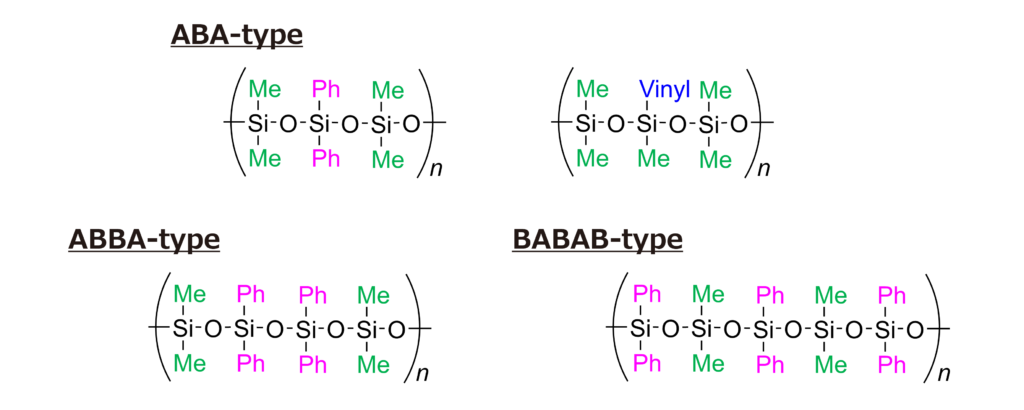Precise Assembly of Inorganic Frameworks for the Creation of New Functions
Our research focuses on the synthesis of inorganic nanomaterials and inorganic-organic nanocomposite materials for applications in various fields such as environment, energy, and medicine. We create unique functions by precisely controlling the composition and structure through molecular design of the building blocks and self-assembly processes.
Precise Inorganic Synthesis
by a Building Block Approach
Periodic Polysiloxanes
Organopolysiloxanes are inorganic polymers with high thermal and chemical stability and are therefore used in various fields. In addition to the combinations and ratios of the comonomers with different organic substituents, the control of the monomer sequences is important for the precise tuning of the properties of polysiloxanes. We have successfully synthesized ABA-, ABBA-, and BABAB-type periodic polysiloxanes by polycondensation of linear oligomers with symmetric structures.

3D Nanoporous Materials
Cage-type siloxanes are useful as building blocks of 3D nanoporous materials because of their rigid polyhedral structures and various functional groups modified at their corners. We are focusing on the creation of new nanoporous materials with unique structures and functions that differ from conventional nanoporous material such as zeolites by the molecular design of the cage-type siloxanes toward applications in separation, adsorption, and catalysis.

T. Hikino, K. Fujino, N. Sato, H. Wada, K. Kuroda, A. Shimojima, Chem. Lett., 50, 1643 (2021).
T. Hayashi, N. Sato, H. Wada, A. Shimojima, K. Kuroda, Dalton Trans., 50, 8497 (2021).
A. Shimojima, K. Kuroda, Molecules, 25, 524 (2020).
N. Sato, K. Tochigi, Y. Kuroda, H. Wada, A. Shimojima, K. Kuroda, Dalton Trans., 48, 1969 (2019).
N. Sato, Y. Kuroda, H. Wada, A. Shimojima, K. Kuroda, Chem. Eur. J., 24, 17033 (2018).
Layered Silica Materials
Layered silicates, composed of two-dimensional crystalline silicate layers, possess reactive sites on the surfaces and exchangeable cations between the layers. We have used layered silicates as nanobuilding blocks to synthesize thin plate-like zeolites through topotactic conversion. Layered silica–organic hybrid materials with regularly arranged organic functional groups have also been prepared by modifying the reactive sites on the interlayer surfaces.

M. Yatomi, M. Koike, N. Rey, Y. Murakami, S. Saito, H. Wada, A. Shimojima, D. Portehault, S. Carenco, C. Sanchez, C. Carcel, M. Won Chi Man, K. Kuroda, Eur. J. Inorg. Chem., 1836 (2021).
M. Koike, R. Sakai, S. Enomoto, T. Mino, N. Sugimura, T. Gotoh, H. Wada, A. Shimojima, K. Kuroda, Dalton Trans., 49, 8067 (2020).
Y. Asakura, M. Sugihara, T. Hirohashi, A. Torimoto, T. Matsumoto, M. Koike, Y. Kuroda, H. Wada, A. Shimojima, K. Kuroda, Nanoscale, 11, 12924 (2019).
M. Koike, Y. Asakura, M. Sugihara, Y. Kuroda, H. Tsuzura, H. Wada, A. Shimojima, K. Kuroda, Dalton Trans., 46, 10232 (2017).
Creation of Siloxane Materials with
Dynamic Functions
Self-Healing Materials
Self-healing materials are long-lived and maintenance-free materials that spontaneously repair damages under mild conditions. We have prepared siloxane-based thin films and elastomers that can repair damages at the molecular level by rearrangement of the siloxane networks by bond cleavage and reformation.

S. Kodama, Y. Miyamoto, S. Itoh, T. Miyata, H. Wada, K. Kuroda, A. Shimojima, ACS Appl. Polym. Mater., 3, 4118 (2021).
S. Itoh, S. Kodama, M. Kobayashi, S. Hara, H. Wada, K. Kuroda, A. Shimojima, ACS Nano, 11, 10289 (2017).
Photoresponsive Materials
Photoresponsive materials that change their shapes upon light irradiation are expected to be useful for photoactuators. We have prepared siloxane-based hybrid photoresponsive materials with high thermal stability by self-assembly of silane and siloxane compounds functionalized with organic chromophores, such as azobenzene and diarylethene.

R. Kajiya, H. Wada, K. Kuroda, A. Shimojima, Chem. Lett., 49, 327 (2020).
R. Kajiya, S. Sakakibara, H. Ikawa, K. Higashiguchi, K. Matsuda, H. Wada, K. Kuroda, and A. Shimojima, Chem. Mater., 31, 9372 (2019).
S. Guo, K. Matsukawa, T. Miyata, T. Okubo, K. Kuroda, A. Shimojima, J. Am. Chem. Soc., 137, 15434 (2015).
Morphologics of Inorganic Nanostructures
Silica Nanoparticles
We have focused on controlling the nanostructures of silica nanoparticles for application in drug delivery systems (DDSs), which have become increasingly important in recent years. For application as a drug delivery carrier, the drug release and the degradation of the carrier particles must occur at a specific time and a specific location. In order to control these behaviors, we have controlled the pore structure of silica nanoparticles and the organic species introduced.

T. Watanabe, E. Yamamoto, H. Wada, A. Shimojima, K. Kuroda, Bull. Chem. Soc. Jpn., 94, 1602 (2021).
T. Watanabe, E. Yamamoto, S. Uchida, L. Cheng, H. Wada, A. Shimojima, K. Kuroda, Langmuir, 36, 13833 (2020).
E. Yamamoto, S. Uchida, A. Shimojima, H. Wada, K. Kuroda, Chem. Mater., 30, 540 (2018).
Ordered Porous Oxides
We synthesize ordered porous materials with novel morphologies using colloidal crystals of regularly arranged silica nanospheres. Cystalline mesoporous silica was synthesized through crystallization of the amorphous silica nanospheres. Furthermore, by using the silica colloidal crystals as a template, we have prepared porous metal oxides with promising applications as energy conversion materials such as thermoelectric materials. This template method is also applied to the preparation of ordered porous elastomers with flexible organosiloxane frameworks.

Y. Saito, T. Matsuno, Q. Guo, T. Mori, M. Kashiwagi, A. Shimojima, H. Wada, K. Kuroda, ACS Appl. Mater. Interfaces, 13, 15373 (2021).
N. Muramoto, T. Matsuno, H. Wada, K. Kuroda, A. Shimojima, Chem. Lett., 50, 1038 (2021).
T. Matsuno, T. Nakaya, Y. Kuroda, H. Wada, A. Shimojima, K. Kuroda, Chem. Asian J., 16, 207 (2021).
N. Muramoto, T. Sugiyama, T. Matsuno, H. Wada, K. Kuroda, A. Shimojima, Nanoscale, 12, 21155 (2020).
T. Matsuno, Y. Kuroda, M. Kitahara, A. Shimojima, H. Wada, K. Kuroda, Angew. Chem. Int. Ed., 55, 6008 (2016).